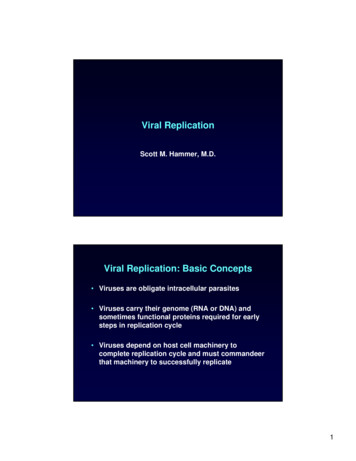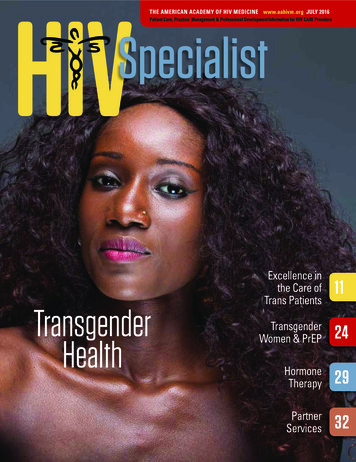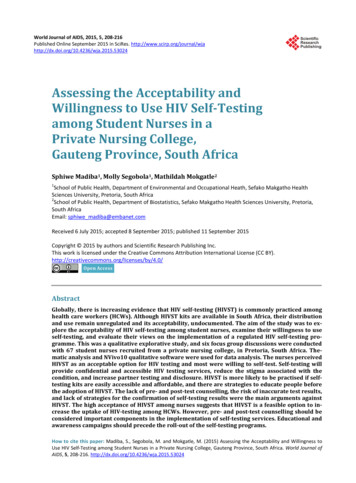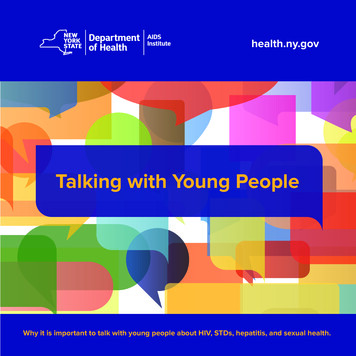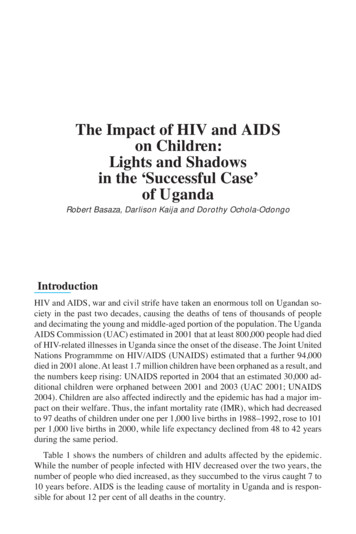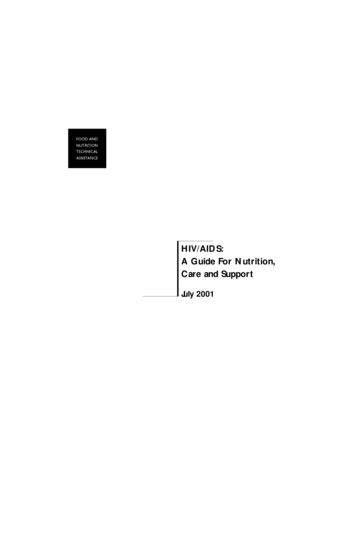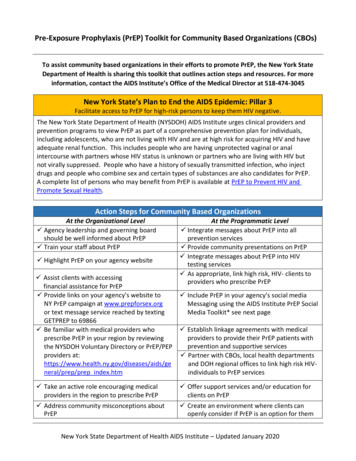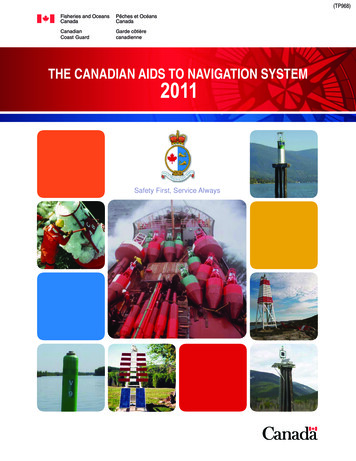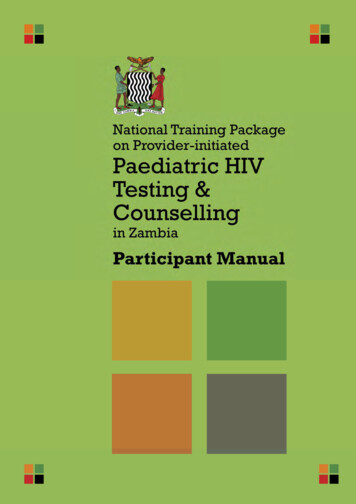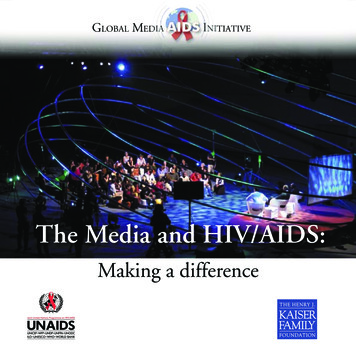
Transcription
GLOBAL MEDIA AIDS INITIATIVEThe Media and HIV/AIDS:Making a difference
Cover photo : MTVYoung people from around the world interacting with celebrities and AIDS experts during the launch ofthe MTV Staying Alive campaign at the XIV International AIDS ConferenceUNAIDS/03.58E (English original, January 2004) Joint United Nations Programme on HIV/AIDS(UNAIDS) 2004.All rights reserved. Publications produced by UNAIDScan be obtained from the UNAIDS Information Centre.Requests for permission to reproduce or translateUNAIDS publications—whether for sale or for noncommercial distribution—should also be addressed to theInformation Centre at the address below, or by fax, at 41 22 791 4187, or e-mail: publicationpermissions@unaids.org.The designations employed and the presentationof the material in this publication do not imply theexpression of any opinion whatsoever on the part ofUNAIDS concerning the legal status of any country,territory, city or area or of its authorities, or concerningthe delimitation of its frontiers or boundaries.The mention of specific companies or of certainmanufacturers’ products does not imply that they areendorsed or recommended by UNAIDS in preference toothers of a similar nature that are not mentioned. Errorsand omissions excepted, the names of proprietaryproducts are distinguished by initial capital letters.UNAIDS does not warrant that the informationcontained in this publication is complete and correctand shall not be liable for any damages incurred as aresult of its use.WHO Library Cataloguing-in-Publication DataThe media and HIV/AIDS : making the difference.1.HIV infections – prevention and control 2.Acquired immunodeficiency syndrome –prevention and control 3.Mass media – utilization 4.Television – utilization5.Information dissemination 7.Predjuce 6.World health I.UNAIDS.ISBN 92 9173 350 4(NLM classification: WC 503.6)UNAIDS – 20 avenue Appia – 1211 Geneva 27 – SwitzerlandTelephone: ( 41) 22 791 36 66 – Fax: ( 41) 22 791 41 87E-mail: unaids@unaids.org – Internet: http://www.unaids.org
The media and HIV/AIDS‘‘When you are working to combat a disastrous and growingemergency, you should use every tool at your disposal. HIV/AIDS is theworst epidemic humanity has ever faced. It has spread further, faster andwith more catastrophic long-term effects than any other disease. Its impacthas become a devastating obstacle to development. Broadcast media havetremendous reach and influence, particularly with young people, whorepresent the future and who are the key to any successful fight againstHIV/AIDS. We must seek to engage these powerful organizations as full’’partners in the fight to halt HIV/AIDS through awareness, prevention,and education.— Kofi Annan, United Nations Secretary-General
UNAIDSThe global HIV/AIDS epidemicToday, 8,000 people will lose their lives to HIV/AIDS and another 14,000—10 people everysingle minute—will become newly infected.The realities of today’s global epidemic are graver than even the worst-case predictions of 10 yearsago. AIDS killed more than 3 million people in 2003 and an estimated 5 million more becameinfected—bringing to some 40 million the number currently livingwith the virus. More than 20 million have already died since the firstclinical evidence of the disease was reported in 1981.UNAIDS / R.BowmanSub-Saharan Africa remains the worst-affected region of the world,with one in five adults across southern Africa now HIV-infected.In countries such as Botswana and Swaziland, adult prevalenceis approaching 40%. In many areas, AIDS is erasing decades ofprogress made in human development as young, productive peopledie, households fall into poverty, and the costs of the epidemicmount. Average life expectancy in the region has declined from 62years to 47, and continues to fall.Posters on bus stops in New York forthe United Nations General AssemblySpecial Session on HIV/AIDSIn other parts of the world, the epidemic also shows no signof abating. Eastern Europe and Central Asia are experiencingexponential expansions in levels of HIV infection, especially amongthe young. More than 1 million people in Asia and the Pacificbecame HIV-positive last year, while, in Latin America and theCaribbean, the epidemic is well entrenched; HIV/AIDS is a leadingcause of death in a number of countries in the Caribbean Basin.5The media and HIV/AIDS
UNAIDSADULTS AND CHILDREN ESTIMATED TO BE LIVING WITH HIV/AIDS, END 2003Western EuropeNorth AmericaEastern Europe & Central Asia520 000 – 680 000790 000 – 1.2 millionNorth Africa& Middle EastCaribbean350 000 – 590 000Latin America1.3 – 1.9 million470 000 – 730 0001.2 – 1.8 millionEast Asia & Pacific700 000 – 1.3 millionSouth & South-East Asia4.6 – 8.2 millionSub-SaharanAfrica25.0 – 28.2 millionAustralia& New Zealand12 000 – 18 000TOTAL: 34 - 46 MILLIONSource: UNAIDS/WHOEven in resource-rich nations such as the United States, where overall infection rates are relativelylow, there has been no decrease in the number of new infections in over a decade and, amongcertain populations, HIV prevalence is increasing. A trend towards growing infection rates isalso evident in the Middle East and North Africa, challenging the notion that any region hassidestepped the epidemic.UNAIDS and WHO estimate that, without dramatic increases in HIV-prevention efforts, some45 million new infections will occur worldwide by 2010.The media and HIV/AIDS6
Over the past three years, and in particularsince the adoption by all members ofthe United Nations of a Declaration ofCommitment on HIV/AIDS in 2001, anew momentum has resulted in greatlyincreased resources and renewed politicalcommitment to fight the epidemic.However, efforts still fall far short of whatis needed and much remains to be doneto reach the United Nations MillenniumDevelopment Goal of halting andBillboard from KNOW HIV/AIDS campaignbeginning to reverse the spread of HIVby 2015.Reaching this target and substantially reducing the global impact of this devastating epidemicrequires collaboration from all sectors of society: educational institutions, government, religiousorganizations, and the mass media.In a landmark gathering in June 2001, Heads of State and Representatives ofGovernments met at the United Nations General Assembly Special Session onHIV/AIDS and fashioned a set of global commitments for tackling the epidemic.They affirmed, for example, that :Beyond the key role played by communities, strong partnerships among governments, theUnited Nations system, people living with AIDS and vulnerable groups, the media,parliamentarians, foundations, community organisations and traditional leaders areimportant (para. 32).—From the Declaration of Commitment on HIV/AIDS, adopted at the United Nations GeneralAssembly Special Session on HIV/AIDS, 27 June 2001, New York.7The media and HIV/AIDSViacomUNAIDS
UNAIDSThe media: a response to HIV/AIDSThe media have a pivotal role to play in the fight against AIDS. It is often said that educationis the vaccine against HIV. Many media organizations are rising to the challenge by promotingawareness of HIV/AIDS and educating listeners and viewers about the facts of the epidemic andhow to stop it.According to national surveys conducted in the United States, 72% of Americans identifytelevision, radio and newspapers as their primary source of information about HIV/AIDS,more than doctors, friends and family. Similar statistics have also been reported in the UnitedKingdom and elsewhere in the world.In a survey carried out in India more than 70% of respondents said they had received theirinformation about HIV/AIDS from television.Clearly, media organizations havean enormous influence in educatingand empowering individuals to avoidcontracting HIV. Doing so withmaximum efficiency, however, requiresa clear understanding of the challengesand the obstacles to widespread andeffective HIV-prevention education.Recording the Tinka Tinka Suhk, radio soapopera, IndiaThe media and HIV/AIDS8Richard Stanley
UNAIDS Widespread lack of awarenessLevels of awareness of, and knowledgeabout, HIV/AIDS vary widelyaround the world. According torecent surveys from over 40 countries,more than half of young people mostat risk—those aged 15–24—haveserious misconceptions about how thevirus is transmitted.UNAIDS/ Liba TaylorCredit photoA surprising number of people,especially the young, have simplynever heard of HIV. In 21 Africancountries, more than 60% of youngWorld AIDS Day activities in Ukrainewomen, for example, have eithernever heard of the virus or have atleast one major misconception about how it is spread. In Lesotho, a country with a very highHIV prevalence rate, only 2 out of 10 girls have sufficient knowledge about it. While most youngwomen in Ukraine have heard of HIV/AIDS, only about 10% can correctly identify the threeprimary ways to avoid infection: abstinence, fidelity and consistent condom use.At the United Nations General Assembly Special Session on HIV/AIDS in June 2001,governments of the world agreed that they would:By 2005, ensure that 90%, and, by 2010, 95% of youth aged 15–24 have information,education, services and life skills that enable them to reduce their vulnerability to HIVinfection (para. 53).—From the Declaration of Commitment on HIV/AIDS, adopted at the United Nations GeneralAssembly Special Session on HIV/AIDS, 27 June 2001, New York.9The media and HIV/AIDS
UNAIDSMost know little about HIV preventionPercentage of young women (aged 15–19) who have heard of AIDS and % who know the threeprimary ways of avoiding infection*10084 85 857567Knowledge (%)54 5469738890 919795 95 96 9693 93 93 9499 99 9976 77675957 58565050414138383328262424232533Know thethree mainways ofavoidinginfection3022201915362927Heard ofAIDS464416149951UkraineCubaDominican RepublicGuyanaBosnia and HerzegovinaU. Rep. of TanzaniaTrinidad and TobagoBotswanaRep. of MoldovaSuriname*Three primary ways (ABC): Abstinence; Be faithful; Consistent condom useCambodiaCôte d'IvoireYugoslavia (FR)KenyaCameroonComorosViet NamBoliviaGambiaChadLesothoNigerSenegalGuinea BissauUzbekistanSierra LeoneMadagascarSomaliaAzerbaijan0Source: UNICEF/MICS, Measure DHS, 1999-2001.Even after 20 years, misconceptions abound. In Latin America and the Caribbean—a regionseverely affected by HIV—there are still large numbers of people who are not well informed. Astudy in the United States in the year 2000 found that 40% of respondents thought they couldcontract HIV from sharing a drinking glass, and a similar number believed the virus could beairborne and transmitted through a cough. A quarter of adults in the United Kingdom—morethan 10 million people—feel they do not know enough about how the risks of HIV couldpotentially relate to them.The media and HIV/AIDS10
UNAIDSSoul City Institute of Health and DevelopmentCommunication‘Joseph’, a characterin the Soul City soapopera overcomesdiscrimination becauseof his HIV status,South Africa The triangle of denial, stigma and discriminationBeyond lack of information, there is also denial. Many people in all parts of the world have notyet accepted that the risk of contracting HIV applies to them. For instance, more than 90%of adolescents in Haiti believe they have a tiny or non-existent risk of contracting it, while thenation actually has one of the highest prevalence rates outside sub-Saharan Africa.Denial about the virus exists on both personal and societal levels. Many continue to believe thatAIDS is an issue for ‘others’. Equally damaging to the effort to disseminate factual informationabout the epidemic is the belief, widespread in a number of societies, that HIV/AIDS is somethingthat happens to people who are immoral and socially deviant. In addition to strengthening thestigma and discrimination that keep many from seeking information or help if they are infected,these beliefs promote denial, allowing many in society to distance themselves from the realities ofthe epidemic, and therefore to be lulled into a false sense of security.11The media and HIV/AIDS
UNAIDSPassions and responses evoked by fear and misunderstanding over HIV/AIDS can be extreme.According to one Ukrainian quoted in a UNICEF report, “Sex workers and drug users areperverted elements of society HIV/AIDS is a disease of the depraved”.Such a reaction is all too common. In a UK survey, 57% of respondents said those who becameinfected through unprotected sex “only have themselves to blame”. Nearly 20% of respondentsin the US also believed that people who acquired HIV through sex or drug use had got what theydeserved.At the United Nations General Assembly Special Session on HIV/AIDS in June 2001,governments of the world affirmed that :Stigma, silence, discrimination and denial, as well as lack of confidentiality, undermineprevention, care and treatment efforts and increase the impact of the epidemic on individuals,families, communities and nations (para.13).—From the Declaration of Commitment on HIV/AIDS, adopted at the United Nations GeneralAssembly Special Session on HIV/AIDS, 27 June 2001, New York.These attitudes towards HIV/AIDS fuel both official and unofficial discrimination. Infectedindividuals, or those perceived to be at risk, have been shunned by their communities, have beendenied access to services or health care, and have lost their job. Children have been forced out ofschools. The results of stigma and discrimination can be far-reaching. According to UNAIDS,they are the “greatest barriers to preventing further infections, providing adequate care, supportand treatment and alleviating impact”. The impact of gender inequalityAround the world, women are increasingly at risk from HIV and bear the brunt of stigma anddiscrimination. Because women often lack freedom of choice, they sometimes find it harder toavoid HIV infection. Many women may be aware of what they should do to protect themselves,but are unable to take precautions because of powerlessness, economic dependence on theirThe media and HIV/AIDS12
UNAIDS/Chris SattlbergerUNAIDSWomen are especiallyvulnerable to HIV/AIDSpartners and fear of violence if they refuse sex. Rape is also often a reality. Nearly 50% of youngwomen in 9 Caribbean countries have said that their first sexual intercourse was forced.Other women, for whom violence is not a factor, may feel that it is simply their duty to pleasetheir man, even to the detriment of their own well-being. Reversing rising HIV infection rates inwomen will require addressing these fundamental issues concerning how men and women relateto one another.According to one Kenyan husband quoted in a book by the NGO Panos, AIDS and Men: TakingRisks or Taking Responsibility?, “I am the lion of the house and my wife does not have the right tosay no”. Given such attitudes, women are at high risk of infection.13The media and HIV/AIDS
UNAIDSWhat the media can doThere are a number of things that the media can do to stem the tide of HIV/AIDS infection, andindeed many organizations are already engaged in successful efforts to both raise awareness andpromote sustainable behaviour change to reduce vulnerability to the virus. Talking about itOne of the most obvious roles of media is to open channels of communication and fosterdiscussion about HIV and interpersonal relationships.Addressing HIV/AIDS in entertainment programmes can have an enormous impact on a societyat risk. A number of researchers have notedthat the Radio Tanzania soap opera Twendena Wakati (Let’s Go with the Times), which wasfirst broadcast in 1993, has greatly increasedlisteners’ willingness to discuss issues related tothe virus. In short, the show got people talking.After the programme had been aired for severalseasons, evaluations reported that 65% ofrespondents said they had spoken to someoneabout Twende na Wakati and more than 8 in 10reported having adopted an HIV-preventionmeasure as a result of listening to the show.Uganda has dramatically reduced its HIVinfection rate, primarily through efforts toencourage frank and open discussion of thedisease, its causes, and how to prevent it.The media have helped facilitate this discourse.The media and HIV/AIDSUNAIDS/G PirozziYoung people reading Straight Talk, a youth newspaper, Kenya14
UNAIDSRichard StanleyUgandan experts believe that the simple act of talking has made a profound difference to the courseof the country’s epidemic. The fact that President Yoweri Museveni has allowed a free discussion onHIV/AIDS in the media, among organizations and in civil society is cited as a key element of thecountry’s success in reversing the epidemic.This discussion has been promoted andfostered across genders and generations, withmen and women encouraged to talk to eachother and to their sons and daughters.There are numerous examples of Ugandansbeing given space to discuss HIV/AIDS.The Straight Talk Foundation, which hasa strong media department, fosters anenvironment in which young people canexplore delicate and intimate issues. Thefoundation publishes a range of newspapersand also produces a weekly radio programmein English and a number of local languages. The radio soap opera Tinka Tinka Sukh being tested onan audience in Kerala, IndiaThrough these popular shows, made by andfor young people, listeners can hear theirpeers discuss sex and relationships in a clear and straigthforward manner, as well as how to keepthemselves safe. Creating a supportive and enabling environmentMass media can be instrumental in breaking the silence that surrounds the disease and in creatingan environment that encourages discussion of how individuals can protect themselves and changetheir behaviour, if necessary. While this may mean combating existing social norms, values andconditions, it is not necessarily as difficult and daunting as it might appear. There are numerousexamples in which media interventions have made positive changes in society. For instance, theIndian village, Lutsaan, turned its back on the dowry system after listening communally to a radiosoap opera broadcast on All India Radio called Tinka Tinka Sukh (Little steps to a Better Life).15The media and HIV/AIDS
UNAIDSThe popular South African soap opera, Soul City, developed by an NGO, the Soul City Instituteof Health and Development Communication, has been aired by the South African BroadcastingCorporation (SABC) since 1994. It has brought about social policy change at a national level. Theseries, which primarily deals with HIV/AIDS, also examined domestic violence in its fourth run,when one character, a respected teacher, abused his wife. Advocacy pressure from Soul City and TheNational Network on Violence against Women, a grass-roots coalition of activists, led to the swiftimplementation of the Domestic Violence Act in 1999. Government departments acknowledgedthat their actions were influenced by the media campaign.In each of these examples, broadcasters broke new ground and challenged what had previouslybeen socially acceptable, in ways that did not alienate, but rather attracted, audiences. Challenging stigma and discriminationTakalani SesameHIV-related stigma and discrimination are major barriersto effective prevention and, in fact, have been identified asmajor risk factors for HIV transmission. A number of mediacampaigns have focused on the need to overcome prejudiceand encourage solidarity with people who are infected with,or affected by, the virus.The UN Secretary-General appearswith Kami, the HIV-positive muppet, in apublic service messageThe media and HIV/AIDSSouth Africa’s Sesame Street, known as Takalani Sesame,has demonstrated that it is never too early to challengeHIV/AIDS-related stigma. Kami (the Tswana word for‘acceptance’) is an energetic and lively golden muppet withginger hair, who joined the show in September 2002. Kamialso happens to be HIV-positive. The show has includedstorylines wherein Kami has had to cope with beingostracized at school because of her status but has overcomethe prejudice of her friends and taught them the value oftolerance.16
UNAIDS Promoting HIV/AIDS servicesCollaboration between broadcasters, grass-roots organizations, service providers and governmentagencies can help to ensure that vital services, such as counselling and testing, condom provision,and even treatment and care, are available on the ground.The weekly award-winning television soap SIDA dans la Cité (AIDS in the City), produced in Côted’Ivoire and shown on Ivorian Radio and Television (RTI) and across French West Africa, is a goodexample of how the promotion of condoms can be linked directly to their subsequent availability.The series revolves around the life of a family affected by HIV/AIDS and is produced as the keypart of a condom social marketing campaign by Population Services International (PSI), Côted’Ivoire and a local partner. PSI promotes condom use through the programme and makes sure thatcondoms are available to the audience. A survey found that those who had seen 10 or more episodesUNAIDS/Stefan Attardof the show were significantly more likely to have used acondom than were non-viewers.Billboard produced by the Health Promotion Department,MaltaBroadcasters can also join with partners to educate aboutHIV/AIDS and publicize the availability of services.The Kaiser Family Foundation, for example, partnerswith top media companies, such as Black EntertainmentTelevision and Univision, the leading Spanishlanguage television company in the United States, toreach key populations – African American and Latinoyouths, respectively. These extensive public educationpartnerships promote dedicated toll-free hotlines andwebsites to direct viewers seeking more information tolocal HIV counselors or testing centers. Collectively,these efforts connect hundreds of thousands of youngpeople with services every year.17The media and HIV/AIDS
UNAIDS Educating and entertainingTo be effective, messaging about HIV/AIDS must be both educational and entertaining. Thesetwo goals should not be mutually exclusive. A number of programmes have served to informtheir audiences about the virus while, at the same time, achieving market success.In India, Doordarshan, the national television service, the National AIDS Control Organisation(NACO) and the BBC World Service Trust, (the international development arm of the BritishBroadcasting Corporation), joined forces in 2002 to launch the country’s first-ever massmedia campaign to increase awareness of HIV/AIDS. The campaign has been largely based oneducation through entertainment, with two key strands being the popular interactive detectiveseries Jasoos (Detective)Vijay and the award-winning weekly ‘reality’ youth show, Haath se HaathMilaa (Let’s Join Hands).DoordarsNation han/BBC Woal AIDSrld ServControicl Organ e Trust/isationPublicity for Jasoos (Detective) Vijay and Haath seHaath Milaa (Let’s Join Hands), television serials,IndiaThe media and HIV/AIDS18
UNAIDSBoth programmes have proved popular with audiences and Jasoos Vijay was voted ‘Best ThrillerSeries’ in the prestigious Indian Television Awards 2003. Viewers are therefore given informationabout the virus and how to protect themselves while watching an enjoyable programme atthe same time. For example, according to an independent survey, 85% of respondents to thecampaign said they had learned something new and almost a third said they had discussedmessages with friends.loveLifeIn Brazil, home of the extraordinarily popular ‘telenovela’, or television soap opera, the TVGlobo company placed an HIV-themed serial at the heart of its programme schedule. Malhaçao(Working Out), dealing with issues facing young people in Brazil, captured huge audienceswhen its teenage protagonist learned that she was HIV-positive. The move by the BrazilianGovernment to begin distribution of free antiretroviral drugs was also mirrored in Malhaçao’sstoryline. When dramatized in a compelling manner, ‘socially responsible’ soap operas can attractand help to educate large numbers of viewers and listeners.One of the most keenly watched programmes in Nicaragua is Sexto Sentido (Sixth Sense), a hard-hitting‘social soap opera’ that tackles issuessuch as sexuality, rape, domesticviolence and substance abuse. Itreaches 80% of 13–17-year-oldsand is the highest-rated show in itstime slot.South Africa’s loveLife campaign,launched in late1999, combinesa highly visible and sustainedmulti-media awareness andCampaign material targeting youth, South Africaeducation campaign withdevelopment of youth friendly services and support programmes countrywide. loveLife is able togreatly extend the scale and scope of its media campaign through cost-sharing partnerships withkey media organizations. The South African Broadcasting Corporation is loveLife’s broadcast19The media and HIV/AIDS
Richard StanleyUNAIDSpartner providing extensive radio andtelevision airtime, as well as co-productionfunding. Respondents in a national surveyof youth reported changes in their sexualbehaviour, including greater abstinence, delayof sexual debut and increased condom use,as a result of this programming. More thanthree quarters said loveLife had made themaware of the risks involved in unprotected sex.There are numerous examples of otherprogrammes around the world that haveechoed this success. For example, NHK, thenational television network in Japan, airedShooting of Bai Xing soap opera, CCTV, Chinaa serial called Kamisama Mo Sukoshidake(Please God, Just a Little More Time) that revolved around a schoolgirl who was HIV-infected afterbecoming a sex worker. During the programme’s run, the number of HIV tests and requests forcounselling more than doubled in Japan.In China, CCTV and a number of partners, including PCI (Population CommunicationsInternational), have brought the soap opera Bai Xing (Ordinary People) to millions of viewers. Theyhave been able to follow the struggles of Lüye and her family as they tackle many issues, not least ofwhich are the problems brought by HIV/AIDS. Bai Xing has proved a popular and award-winningshow.Broadcasters have also encouraged audiences to become actively involved in combating HIV/AIDSthemselves. The French company, TV5, has played an integral role in promoting the Scenariosfrom Africa competition in which young people are asked to submit a proposal for a short film onAIDS. The winning concept is produced and aired by several national and international networks,including TV5. This competition reflects the company’s policy of placing African voices at the veryheart of its coverage of the epidemic.The media and HIV/AIDS20
UNAIDS MainstreamingBroadcasters are ‘mainstreaming’ the HIV issue across a number of programmes, ensuring thatthe message permeates a diverse range of output, not just outlets and public service messagesdedicated specifically to the issue. The fact that the virus affects all sections of society and allwalks of life is subtly reinforced if it is explored in this way. As a result, many people who mightnot necessarily pay much attention to a traditional AIDS campaign, or who would not choose towatch AIDS programming, are nevertheless exposed to HIV-related education messages.The most effective media initiatives on HIV have many outlets. A coordinated, multifacetedcampaign has greater impact than a single programme. A number of companies haveimplemented this model to great effect. Documentaries, news items, concerts, public serviceannouncements, competitions, hotlines, books and websites can all be linked together toreinforce awareness, information and messages about HIV-related attitudes and behaviour.ViacomFor example Viacom, under its KNOW HIV/AIDS campaign partnership with the Kaiser FamilyFoundation, utilizes all the company’s properties to disseminate information about HIV/AIDS,including targeted public service messages on television,radio and outdoor, integrated messages in TV shows, specialprogramming, in-store and in-product advertising, as well ascomplementary online and print resources. In the first twoyears alone, Viacom will have committed more than US 240million in media space across its properties to the effort.Billboard from KNOW HIV/AIDS campaign21The media and HIV/AIDS
UNAIDS Putting HIV/AIDS on the news agenda andencouraging leaders to take actionAnother key area for media involvement in AIDS education efforts is ensuring that the topic iskept at the top of the news agenda. In recent years, several leading broadcasters from around theworld have found innovative ways to report on the epidemic.The BBC World Service launched a two-week season of programming, including news reports,documentaries, and online coverage of the epidemic to mark World AIDS Day 2003. Thecompany’s high-profile interviews with several world leaders and celebrities, along with phone-insand ‘webchats’ with other public figures, generated broad coverage of HIV for audiences aroundthe world.The Chinese national station, China Central Television (CCTV), broadcast some 230 newsitems on HIV/AIDS in the first 10 months of 2003.Since 1996, Spain’s Radiotelevision Espanola (RTVE) has also worked to keep discussion of thevirus in the public domain. Each year, this has led to two months of special programming, aimedat raising awareness, in the lead-up to World AIDS Day.In the US, the Time Warner network, HBO, broadcast a five-part documentary series in thesummer of 2003 entitled Pandemic: Facing AIDS. CNN has also run a special season of HIVrelated programming, which included a large news component.The NTV Channel and the radio station Echo of Moscow (Gazprom) have also ensured thatthe virus has received widespread coverage and been kept near the top of the news agenda,whether through medical news programmes, reports about the epidemic, radio call-ins or studiodiscussions.Metro TV in Indonesia has consistently broadcast HIV/AIDS-related news and featuredcomment and analysis about the epidemic in talk-shows and documentaries.The media and HIV/AIDS22
UNAIDSMounting an effec
Bi ssa u S enega l Ni ger Ch ad Le so . dad and T obago Gu ya na Bo sn ia and He rz egov in a Cu ba Do mi ni an Re publ ic Uk ra in e Heard of AIDS Know the three main ways of avoiding infection. The media and HIV/AIDS 10 UNAIDS 11 The media and HIV/AIDS UNAIDS The triang
